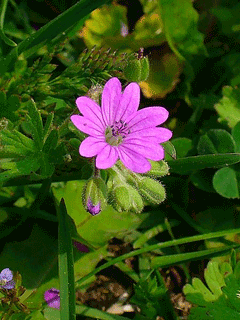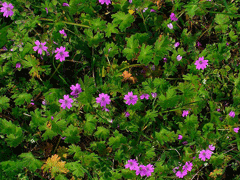 |
|
http://commons.wikimedia.org/wiki/User:Llez |
 |
| http://commons.wikimedia.org/wiki/User:Llez |
Translate this page:
Summary
Physical Characteristics

 Geranium molle is a ANNUAL growing to 0.4 m (1ft 4in). It is in flower from April to September. The species is hermaphrodite (has both male and female organs) and is pollinated by Insects. The plant is self-fertile.
Geranium molle is a ANNUAL growing to 0.4 m (1ft 4in). It is in flower from April to September. The species is hermaphrodite (has both male and female organs) and is pollinated by Insects. The plant is self-fertile.
Suitable for: light (sandy), medium (loamy) and heavy (clay) soils. Suitable pH: mildly acid, neutral and basic (mildly alkaline) soils. It cannot grow in the shade. It prefers dry or moist soil.
UK Hardiness Map
US Hardiness Map
Synonyms
Plant Habitats
Cultivated Beds;
Edible Uses
References More on Edible Uses
Medicinal Uses
Plants For A Future can not take any responsibility for any adverse effects from the use of plants. Always seek advice from a professional before using a plant medicinally.
Anodyne Astringent Vulnerary
The plant is considered to be anodyne, astringent and vulnerary[240].
References More on Medicinal Uses
The Bookshop: Edible Plant Books
Our Latest books on Perennial Plants For Food Forests and Permaculture Gardens in paperback or digital formats.

Edible Tropical Plants
Food Forest Plants for Hotter Conditions: 250+ Plants For Tropical Food Forests & Permaculture Gardens.
More

Edible Temperate Plants
Plants for Your Food Forest: 500 Plants for Temperate Food Forests & Permaculture Gardens.
More

More Books
PFAF have eight books available in paperback and digital formats. Browse the shop for more information.
Shop Now
Other Uses
References More on Other Uses
Cultivation details
Succeeds in any moderately fertile retentive soil in a sunny position[200]. Tolerates a wide range of soil types[200]. Members of this genus are rarely if ever troubled by browsing deer or rabbits[233].
References Carbon Farming Information and Carbon Sequestration Information
Temperature Converter
Type a value in the Celsius field to convert the value to Fahrenheit:
Fahrenheit:
The PFAF Bookshop
Plants For A Future have a number of books available in paperback and digital form. Book titles include Edible Plants, Edible Perennials, Edible Trees,Edible Shrubs, Woodland Gardening, and Temperate Food Forest Plants. Our new book is Food Forest Plants For Hotter Conditions (Tropical and Sub-Tropical).
Shop Now
Plant Propagation
Seed - sow spring in a cold frame. When they are large enough to handle, prick the seedlings out into individual pots and plant them out in the summer. Division in spring or autumn. Larger clumps can be replanted direct into their permanent positions, though it is best to pot up smaller clumps and grow them on in a cold frame until they are rooting well. Plant them out in the spring.
Other Names
If available other names are mentioned here
Native Range
TEMPERATE ASIA: Cyprus, Iran, Iraq, Israel, Jordan, Lebanon, Syria, Turkey, Azerbaijan, Russian Federation (Dagestan) TROPICAL ASIA: India (northwest) EUROPE: Denmark, Finland, United Kingdom, Ireland, Norway, Sweden, Austria, Belgium, Switzerland, Czech Republic, Germany, Hungary, Netherlands, Poland, Slovakia, Belarus, Estonia, Lithuania, Latvia, Moldova, Ukraine (incl. Krym), Albania, Bulgaria, Greece (incl. Crete), Croatia, Italy (incl. Sardinia, Sicily), Romania, Serbia, Slovenia, Spain (incl. Baleares), France (incl. Corsica), Portugal AFRICA: Spain (Canarias), Portugal (Madeira Islands), Algeria (north), Egypt (north), Libya (north), Morocco, Tunisia
Weed Potential
Right plant wrong place. We are currently updating this section.
Please note that a plant may be invasive in one area but may not in your area so it's worth checking.
Conservation Status
IUCN Red List of Threatened Plants Status :

| Related Plants
|
| Latin Name | Common Name | Habit | Height | Hardiness | Growth | Soil | Shade | Moisture | Edible | Medicinal | Other |
| Bauhinia purpurea | Orchid Tree, Purple Butterfly Tree, Mountain Ebony, Geranium Tree, Purple Bauhinia | Tree | 10.0 |
9-12
| F | LM | SN | M | 2 | 2 | 4 |
| Geranium bicknellii | Bicknell's cranesbill | Annual/Biennial | 0.6 |
0-0
| | LMH | N | M | 1 | 1 | |
| Geranium dissectum | Cut-Leafed Cranesbill, Cutleaf geranium | Annual | 0.6 |
6-9
| | LMH | N | M | 1 | 2 | 2 |
| Geranium erianthum | Wooly Geranium | Perennial | 0.3 |
3-7
| | LMH | SN | M | 1 | 1 | |
| Geranium incanum | Geranium, Cranesbill | Perennial | 0.4 |
4-9
| F | LMH | N | M | 1 | 0 | |
| Geranium lucidum | Shining geranium | Annual | 0.5 |
6-9
| | LMH | N | DM | 0 | 1 | 2 |
| Geranium macrorrhizum | Bigroot Geranium | Perennial | 0.5 |
4-8
| F | LMH | FSN | DM | 0 | 1 | 3 |
| Geranium maculatum | Spotted Cranesbill, Spotted geranium, Crowfoot, Wild Geranium, Cranesbill | Perennial | 0.6 |
3-10
| M | LMH | N | MWe | 0 | 3 | 2 |
| Geranium nepalense | Nepalese Crane's Bill | Perennial | 1.0 |
6-9
| | LMH | N | M | 1 | 2 | 1 |
| Geranium ocellatum | | Annual | 0.3 |
-
| | LMH | N | M | 0 | 1 | |
| Geranium pilosum | | Perennial | 0.3 |
-
| | LMH | N | M | 1 | 0 | |
| Geranium potentilloides | Native Carrot, Cinquefoil geranium | Perennial | 0.6 |
0-0
| | LMH | N | M | 1 | 0 | |
| Geranium pratense | Meadow Crane's Bill, Meadow geranium, Geranium | Perennial | 1.2 |
5-9
| F | LMH | N | M | 0 | 2 | |
| Geranium pusillum | Small geranium | Perennial | 1.0 |
6-9
| | LMH | N | DM | 0 | 1 | |
| Geranium robertianum | Herb Robert, Robert geranium | Annual/Biennial | 0.4 |
5-9
| | LMH | SN | DM | 0 | 2 | 2 |
| Geranium rotundifolium | Roundleaf geranium | Annual | 0.4 |
6-9
| | LMH | N | M | 0 | 1 | |
| Geranium sibiricum | Siberian geranium | Perennial | 0.2 |
5-9
| | LMH | N | M | 0 | 1 | |
| Geranium solanderi | Solander's Geranium | Perennial | 0.6 |
-
| | LMH | N | M | 1 | 0 | |
| Geranium sylvaticum | Wood Cranesbill, Woodland geranium | Perennial | 1.0 |
4-8
| | LMH | FSN | M | 0 | 0 | 3 |
| Geranium thunbergii | Thunberg's geranium | Perennial | 0.3 |
6-9
| | LMH | N | M | 1 | 1 | |
| Geranium tuberosum | | Perennial | 0.3 |
7-10
| | LMH | N | M | 2 | 0 | |
| Geranium viscosissimum | Sticky Geranium, Sticky purple geranium | Perennial | 0.8 |
6-9
| | LMH | SN | M | 1 | 2 | |
| Geranium wallichianum | | Perennial | 0.3 |
6-9
| | LMH | SN | M | 0 | 2 | 3 |
| Geranium wilfordii | | Perennial | 0.6 |
-
| | LMH | SN | M | 0 | 2 | |
| Heuchera americana | Rock Geranium, American alumroot, Alumroot, Coral Bells, Rock Geranium | Perennial | 0.5 |
4-9
| M | LM | SN | M | 0 | 3 | 2 |
| Pelargonium australe | Ivy Geranium | Perennial | 0.3 |
8-11
| | LM | N | DM | 1 | 1 | |
| Pelargonium capitatum | Rose-Scented Geranium | Shrub | 0.6 |
8-11
| | LM | N | DM | 0 | 3 | 3 |
| Pelargonium crispum | Lemon Geranium | Shrub | 0.7 |
8-11
| | LM | SN | DM | 2 | 2 | 3 |
| Pelargonium exstipulatum | Pennyroyal Geranium | Shrub | 1.0 |
8-11
| | LM | N | DM | 1 | 2 | 2 |
|
|
Growth: S = slow M = medium F = fast. Soil: L = light (sandy) M = medium H = heavy (clay). pH: A = acid N = neutral B = basic (alkaline). Shade: F = full shade S = semi-shade N = no shade. Moisture: D = dry M = Moist We = wet Wa = water.
Now available:
Food Forest Plants for Mediterranean Conditions
350+ Perennial Plants For Mediterranean and Drier Food Forests and Permaculture Gardens.
[Paperback and eBook]
This is the third in Plants For A Future's series of plant guides for food forests tailored to
specific climate zones. Following volumes on temperate and tropical ecosystems, this book focuses
on species suited to Mediterranean conditions—regions with hot, dry summers and cool, wet winters,
often facing the added challenge of climate change.
Read More
Expert comment
Author
L.
Botanical References
17
Links / References
For a list of references used on this page please go here
Readers comment
© 2010, Plants For A Future. Plants For A Future is a charitable company limited by guarantee, registered in England and Wales. Charity No. 1057719, Company No. 3204567.